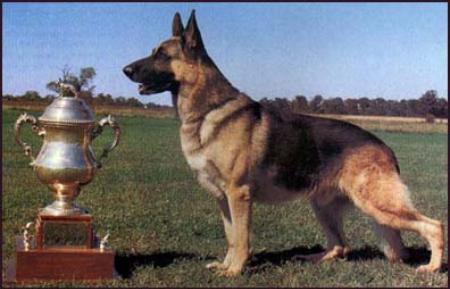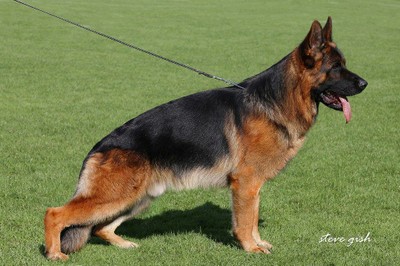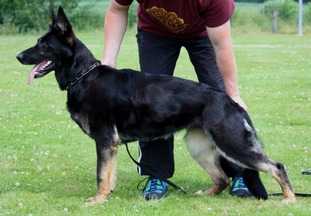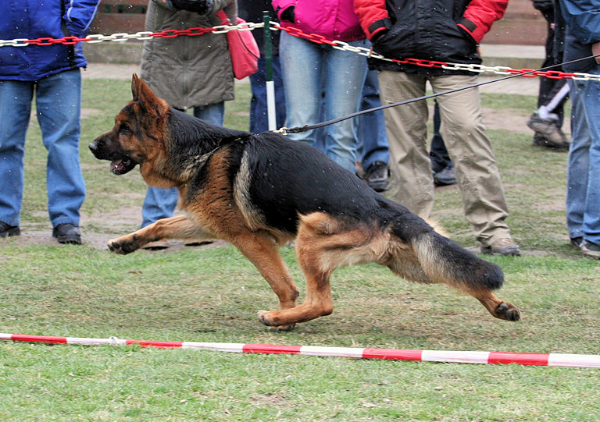
This is a placeholder text
Group text
by palapaguy on 07 November 2017 - 02:11
by Western Rider on 07 November 2017 - 02:11
Can you show us a picture of what you think the 1970's look was and what you say you see now.
Many times it will be the way the dog is stacked. Not saying that there aren't dogs that were bred incorrectly and have way to short back legs or other problems etc.
Just many times it will be the way the dog was posed.
I think you will find many many dogs when posed with a natural stance are not slope backed.
by palapaguy on 07 November 2017 - 04:11
http://www.pedigreedatabase.com/german_shepherd_dog/
But it's typical of many GSD profiles I see. If it's posed, is that for a reason? Like it shows a desirable breed characteristic?
by Western Rider on 07 November 2017 - 04:11
Why or who started this style is not really important what is, is the fact that in the SV style of showing they are again asking for a natural unposed stance in the ring for the Judges. Not that they are really enforcing it.
The natural stance offers less chance to cover up faults.
For pictures many will continue with the posed look.
Those dogs that have more angle and length from knee to top of hock has been a breeding practice that is slowly becoming something less and going back to the rear leg structure of the past. You can find many dog like this if look. Show lines or Working lines.
The American lines bred for the same thing just they added a short hock length which really makes them slope backed.
by Kinolog on 07 November 2017 - 15:11
A German shepherd dog is supposed to be constructed for trotting and the ability to cover a maximum amount of ground with the least amount of effort. The hind legs are constructed in such a way that they act as levers to propel the dog forward.
Also, people mistakenly interpret "straight back" as being parallel to the ground. They also may not differentiate between a correctly angled back from a roached back, which is when the highest point of the back rises above the withers. The dog needs to be still and standing correctly to make this evaluation. You can have dogs that look a little more or a little less extreme. But harmony in build becomes far more important so the front end and back end are correctly matched to make a correct, ground- covering gait.
They say that seeing a GSD standing four-square is a good way to evaluate the dog's conformation because one can stack a dog in such a way as to minimize some faults. The GSD is the only breed I know of that is stacked in conformation shows with one hind leg further forward than the other.
American obsession with huge dogs has gone global. A working dog must be nimble and athletic, and is best as a true medium. A k-9 officer is not going to be boosting a 120 pound monster through someone's bathroom window. Most GSDs are simply not made for that kind of work, but they can still do other jobs just as invaluable to their handlers.
The world is big enough to accommodate the true versatility of the breed.
by Sunsilver on 07 November 2017 - 18:11
Plapayguy, one thing you need to realize is that the breed standard for dogs isn't written in stone. WhaT is acceptable in the show ring does change over time. The wording of the standard also changes over time. We could spend the next couple of hours talking about this, but here's a recap, as brief as I can make it. Let's go back to 1967. There were changes in the GSD prior to this, but I want to answer your question. 1967 was a watershed year for the breed. Bodo von Lierberg was the German, Dutch and Belgian Sieger. He looked like this:
.jpg)
He was exported to the United States, but couldn't do better than Winner's Dog in the show ring, and was used very little for breeding. Instead, this is the dog the Americans chose as their Grand Victor, Lance of Fran-Jo:

American breeders went crazy over Lance, and soon everybody was breeding to him and his sons. You will have to look very, very hard to find an American dog that doesn't have Lance multiple times in their pedigree. This was the start of the trend for American dogs to have a very long upper thigh, a pronounced forechest (prosternum) and a short hock. They also became quite long in the back, much longer than Lance. The American dogs we see in the showring today don't look too much different than this.
Changes in the German dogs began around the mid 1970s, with the rise of the Martin brothers to a position of prominence in the SV. During this era, three kennels dominated the yearly Sieger show:
Hermann Martin's kennel “von Arminius”, his brother Walter’s kennel “von der Wienerau” and the one of his best friend Martin Göbl: “vom Wildsteiger Land”. All current German showlines have the dogs from these kennels in their pedigrees multiple times.
In the Martin era, the winning dogs were chosen for their rich black and red colour, their size, and their sidegate (trotting as fast as possible, with a long stride). Like the American dogs, a very long upper thigh became the norm, as that helps produce a nice, long, showy stride. The judges also believe that a curved spine was the strongest, because it was like the arc of a bridge. This led to the development of a roached back in many of these dogs, where the lumbar area was higher than the withers. (There is not a shred of scientific evidence to support this belief. Many of our top predators have spines that are either straight (wolves, coyotes, foxes) or even slightly concave in the lumbar area (most of the big cats.)
Temperament became secondary, and many of these dog performed poorly in the courage test.
Of course, those breeders that stil cared about working ability weren't happy with the new look, and continued to breed their dogs for working ability. As their dogs now rarely took the higher placings at the annual Sieger show, other shows that stressed working ability became more popular and important to these breeders.
That, in a nutshell, is why the German dogs are now split into working lines and show lines. The working lines still resemble the earlier dogs. They are lighter, faster, have less angulation in the hind legs, and are often sable in colour, as sable is a dominant gene. They can also be any other colour. However, it has been many years since a dog other than black or red has placed in the top 10 (VA placement) at the Sieger show.
Here are the top show line and working line dogs from this year:
VA1 Gary vom Huhnegrab

V2 BSP 2017, V1 WUSV 2017 Debby vom Eisernen Kreuz

Debby was the # 1 dog in the WUSV championships held in the Netherlands, and placed second in the BSP, Germany's yearly championship show for schutzhund dogs. This thread explains the difference between the three shows (BSP, BSZS, WUSV).
http://www.pedigreedatabase.com/community.read?post=187660-what-is-the-bsp
The apparent slope in the back of the showline dogs is due mostly to the increase angulation in the hind legs. This allows the legs to bend at an more extreme angle, and permits them to be stacked with their rear ends lower to the ground. There has also been a change in the angle of the pelvis in the show line GSDs, and that contributes to the rear ends being lower when the dog is stacked. In the American show line dogs, they are often stacked with one hock flat on the ground, so of course, this pose is going to lower the rear and make the back look more sloped.
When the dogs are being gaited in the Sieger show, they are encouraged to pull hard against the leash, and this causes them to dig in more, resulting in a lowered rear end. Here's a rather extreme example of this:

by palapaguy on 08 November 2017 - 01:11
by Sunsilver on 08 November 2017 - 05:11
Then there's the King and Shiloh shepherds, which are about 95% GSD.
by apple on 08 November 2017 - 12:11
by Sunsilver on 08 November 2017 - 15:11
Apple, I was trying hard to explain how this all came about without getting into bashing the show lines. Let's not go there, okay? ![]() That's not what the OP was asking about.
That's not what the OP was asking about.
Contact information Disclaimer Privacy Statement Copyright Information Terms of Service Cookie policy ↑ Back to top




